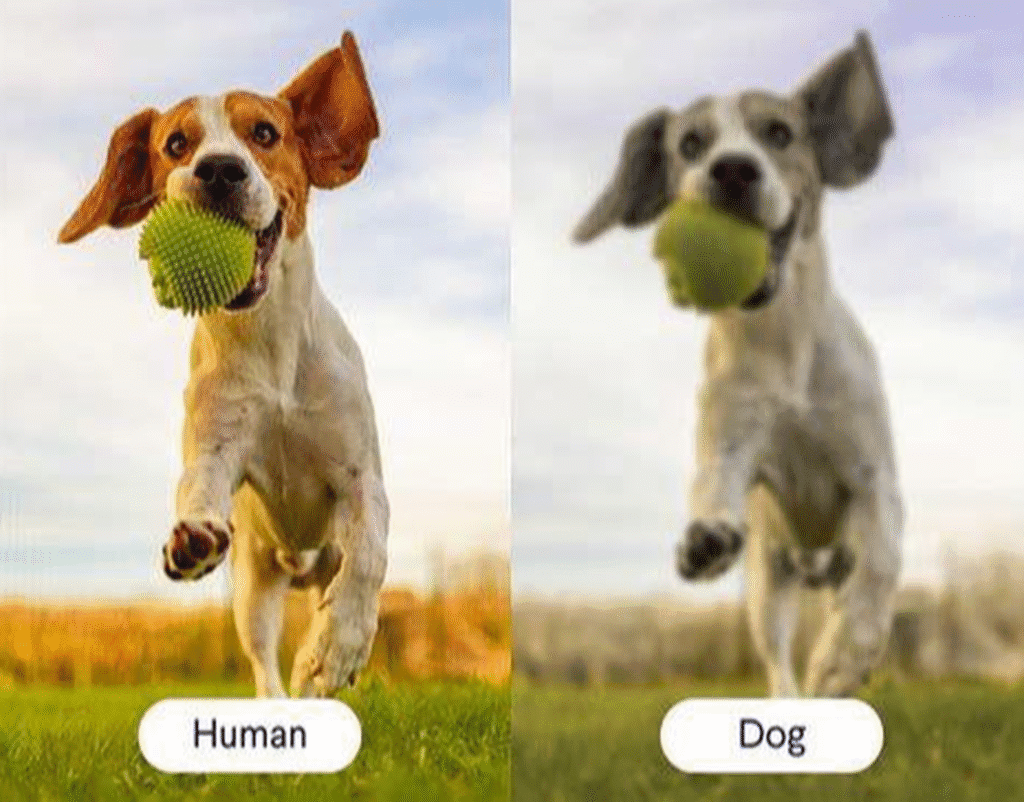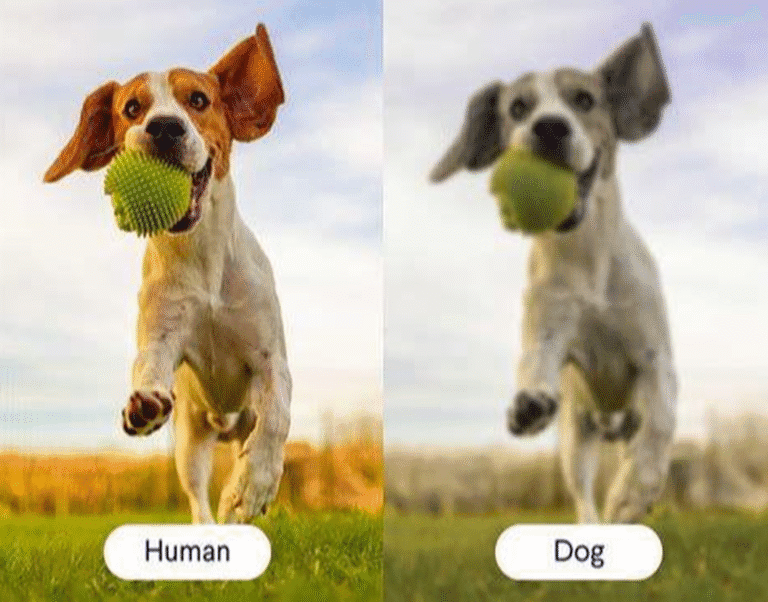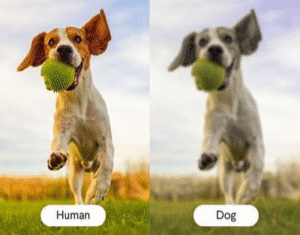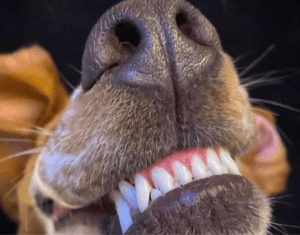
If you throw your dog’s bright red ball onto a lush green lawn and they run past it like it owes them money, are they (A) being dramatic, (B) ignoring you (classic), or (C) actually can’t see the darn thing?
Suppose you said C… winner, winner, liver dinner! Toss in a belly rub for good measure.
Today, we’re diving nose-first into one of the most common and most misunderstood questions from curious dog parents everywhere:
What colors do dogs actually see?
And no, the answer isn’t just “black and white” like your great-aunt Gertrude told you back in 2004. That myth has been debunked harder than the idea that cats care about your personal space. Science has come a long way since the days of guesswork, and it turns out our tail-wagging, zoomie-loving buddies do see color… just not in the rainbowy, high-def way we do.
Daftar Isi
So leash up your curiosity, silence your inner Gertrude, and grab some snacks (treats for them, cookies for you), because we’re about to fetch the full story on your dog’s eye view of the world from the shades they can see to the surprising superpowers hiding behind those goofy, love-filled stares.
First Things First: How Vision Actually Works
Before we zoom in on what colors dogs can actually see, let’s take a quick crash course in eye science. Don’t worry; this won’t feel like your typical high school biology class. Max and Whiskers would stage a full-blown protest if things got too boring.
Both humans and dogs rely on specialized cells in the eyes called photoreceptors, specifically rods and cones. Rods help detect light and motion (a.k.a. why your dog can spot a squirrel in the dark at 50 paces), while cones are responsible for seeing color and fine detail.
Humans have three types of cones, which makes them trichromatic. This is just a scientific way of saying we can see a full spectrum of colors, from vibrant violets and electric blues to fiery reds and sunny yellows.
Dogs, on the other paw, have only two types of cones, making them dichromatic. Translation? Their color range is limited. They see fewer shades than we do, and their world is painted in a much narrower palette.
Imagine humans are looking at life through an ultra-HD, color-enhanced TV screen. Dogs, on the other hand, view things through a slightly muted vintage filter. It’s not black and white, but it’s definitely not technicolor, either.
Now, let’s talk about color blindness. It doesn’t mean a total lack of color; it usually just means that some of the cones responsible for processing certain colors are missing or not working properly. For example, people with red-green color blindness have trouble telling the difference between those two hues. They often blend together or appear as similar shades.
Sound familiar?
That’s exactly what’s happening in your dog’s eyes. Reds and greens tend to blur into one another, which means your dog might not be ignoring their favorite red toy in the grass, they might just not see it the way you do.
So… What Colors Do Dogs Actually See?
Dogs don’t see the world in black and white (thank goodness, because Max’s yellow duck toy would lose all its pizzazz). However, they do see a more limited spectrum.
Here’s the breakdown:
| Warna | How You See It | How Your Dog Sees It |
| Red | Red | Dark brown/grayish |
| Green | Green | Beige or dull yellow |
| Blue | Blue | Blue (yay!) |
| Yellow | Yellow | Yellow (double yay!) |
| Purple | Purple | Blue-ish |
| Orange | Orange | Sort of brownish |
This means dogs can’t distinguish red-green differences, similar to red-green color blindness in humans. In fact, researchers use the term “deuteranopia” to describe a dog’s vision profile.
Here’s a cool analogy:
- Humans see 1 million colors (thanks to trichromatic vision).
- Dogs? Around 10,000 which is still impressive but definitely not rainbow-level.
So if you’ve ever wondered why Max ignores his red ball but goes nuts over the blue frisbee, it’s not just because he’s being picky (well, maybe a little). It’s because he literally can’t see the red one as clearly.
Wait, Is This Why Max Can Never Find His Red Ball in the Grass?
Bingo. You’ve cracked the code, Sherlock.
Green grass + red ball = a recipe for a “Hooman, where’d it go?!” moment. To your dog, both of those colors kind of look the same. It’s like trying to find your beige keys on a beige carpet. You’d struggle, too.
That’s why blue and yellow toys are the MVPs of the dog world; they stand out more clearly against most backgrounds. And they look snazzy in pet photos, too. Just saying.
What’s the Point of All the Colorful Dog Toys
Those bright, flashy toys in reds, oranges, and greens that line the pet store shelves? Hate to break it to you, but they’re made to catch your eye, not your dog’s. Marketers know what looks good on Instagram, but your pup? They couldn’t care less about the color.
To them, that neon red squeaky bone might as well be a grayish-brown blob lost in the grass. Why? So while you’re admiring that cute watermelon-shaped plushie, your dog is more interested in how it smells, how it squeaks, and whether it feels satisfying enough to destroy in five minutes flat.
Now here’s a little tip: If you actually want your dog to see their toys better, especially during a chaotic backyard fetch session, go for blue and yellow. These colors stand out clearly in your dog’s limited color palette and are way easier for them to track mid-run.
So next time you’re choosing between that red rubber ball and a bright blue one? Skip the aesthetic. Pick the one your dog can actually see and chase without turning into a confused four-legged detective.
Are Dogs Bothered by Their Limited Color Vision?
Not at all. In fact, if you asked your dog, “Hey buddy, wish you could see more colors?” he’d probably just blink at you with that adorable blank stare and say, “Do colors taste like bacon?” Dogs don’t miss what they’ve never had. Their world isn’t built around visual beauty, it’s designed around scent trails, moving objects, hearing, and instinct.
So while we humans decorate our lives with vibrant art, color-coded planners, 57 shades of nail polish, and Instagram filters we never actually use, your dog is just out there living large with their perfectly functional blue-and-yellow aesthetic. No fuss, no FOMO, just pure, sniff-filled joy.
What About Dog Training and Colors?
When it comes to training, color can actually play a role, especially if you’re using visual cues like toys, clickers, or even agility equipment.
Here’s the trick:
- Pilih blue or yellow toys and training tools, they’re easier for your dog to spot and respond to.
- Avoid red and green objects when visibility is important (like fetch at the park) unless you want to turn it into an extreme game of hide-and-seek.
Fun story: I once bought Max this fancy, neon green treat ball. Cost me way more than I care to admit. Brought it to the park, Max sniffed it, sneezed on it, then ran in the opposite direction. Meanwhile, Whiskers my cat was sitting in the stroller (yes, the stroller), silently judging me with the cold precision of a feline queen.
Lesson learned: blue toys = better zoomies.
Should I Decorate My Home Based on My Dog’s Color Vision?
Look, unless Max is the one paying rent (in which case, congrats—get that pup a credit card and let him handle utilities too), you don’t need to redecorate your entire home in blue and yellow.
But it is kind of amazing and honestly, pretty thoughtful to consider how your dog experiences their surroundings. Just a few smart tweaks can make their world a whole lot easier to navigate. Think of it as leveling up your dog-parent game.
Here’s how you can subtly color-hack your home for your dog’s vision:
- Choose blue or yellow food bowls so they actually stand out against the floor. A red bowl on a green rug? That’s basically camouflage for your dog.
- Opt for high-contrast beds: a light-colored bed on a dark floor or vice versa. That way, your pup can easily spot their nap zone, especially when they’re sleep-staggering in for their fourth nap of the day.
- Pick easier-to-see leashes and collars (think blue or bright yellow) for safer outdoor time. It’s not just for them; it makes life easier for you too, when they dart toward a squirrel and you can actually track the leash.
At the end of the day, it’s not about turning your house into a canine art gallery or painting everything in primary colors. It’s about simple, helpful choices that make your dog’s daily life smoother.
Bonus Tip for Petfluencers
Trying to capture the perfect pupstagram moment? Here’s a tip:
- Use blue and yellow props for photo sessions, they’ll stand out to your dog and make your pics pop.
- Want them to look toward the camera? Ditch the red squeaky toy. Try a blue or yellow one instead, they’re more likely to track it visually.
Wrapping It All Up: How Dogs See the World
To sum it up, dogs don’t see in black and white. They see shades of blue, yellow, and gray, and that’s perfectly pawsome. Their color vision might be limited compared to ours, but they make up for it with:
- Exceptional motion detection
- Killer night vision
- An absolutely elite sense of smell (that’s a whole other post)
And honestly? They don’t care that they can’t see red. They care that you’re with them, that you throw the ball, and that the treats keep coming. So, next time you’re picking out a new toy, leash, or treat pouch, think blue and yellow. Max says thanks in advance.
Final Bark from Riley
If your dog could read this blog, they’d probably say, “Colors? Eh. Where’s the bacon?” But I’m here to help you see things through their eyes (literally) so you can make smarter choices, laugh a little louder, and spoil them a lot more effectively.
Because pet parenting is messy, chaotic, and absolutely worth it.





